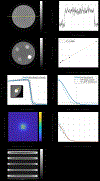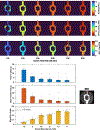Turn-table micro-CT scanner for dynamic perfusion imaging in mice: design, implementation, and evaluation
- PMID: 39137802
- PMCID: PMC11444210
- DOI: 10.1088/1361-6560/ad6edd
Turn-table micro-CT scanner for dynamic perfusion imaging in mice: design, implementation, and evaluation
Abstract
Objective.This study introduces a novel desktop micro-CT scanner designed for dynamic perfusion imaging in mice, aimed at enhancing preclinical imaging capabilities with high resolution and low radiation doses.Approach.The micro-CT system features a custom-built rotating table capable of both circular and helical scans, enabled by a small-bore slip ring for continuous rotation. Images were reconstructed with a temporal resolution of 3.125 s and an isotropic voxel size of 65µm, with potential for higher resolution scanning. The system's static performance was validated using standard quality assurance phantoms. Dynamic performance was assessed with a custom 3D-bioprinted tissue-mimetic phantom simulating single-compartment vascular flow. Flow measurements ranged from 1.51to 9 ml min-1, with perfusion metrics such as time-to-peak, mean transit time, and blood flow index calculated.In vivoexperiments involved mice with different genetic risk factors for Alzheimer's and cardiovascular diseases to showcase the system's capabilities for perfusion imaging.Main Results.The static performance validation confirmed that the system meets standard quality metrics, such as spatial resolution and uniformity. The dynamic evaluation with the 3D-bioprinted phantom demonstrated linearity in hemodynamic flow measurements and effective quantification of perfusion metrics.In vivoexperiments highlighted the system's potential to capture detailed perfusion maps of the brain, lungs, and kidneys. The observed differences in perfusion characteristics between genotypic mice illustrated the system's capability to detect physiological variations, though the small sample size precludes definitive conclusions.Significance.The turn-table micro-CT system represents a significant advancement in preclinical imaging, providing high-resolution, low-dose dynamic imaging for a range of biological and medical research applications. Future work will focus on improving temporal resolution, expanding spectral capabilities, and integrating deep learning techniques for enhanced image reconstruction and analysis.
Keywords: bioprinted phantom; contrast agents; micro-CT; perfusion imaging; preclinical.
© 2024 Institute of Physics and Engineering in Medicine. All rights, including for text and data mining, AI training, and similar technologies, are reserved.
Figures








References
-
- Miles KA and Griffiths MR, Perfusion CT: a worthwhile enhancement? The British Journal of Radiology, 2003. 76(904): p. 220–231. - PubMed
Publication types
MeSH terms
Grants and funding
LinkOut - more resources
Full Text Sources
Miscellaneous
